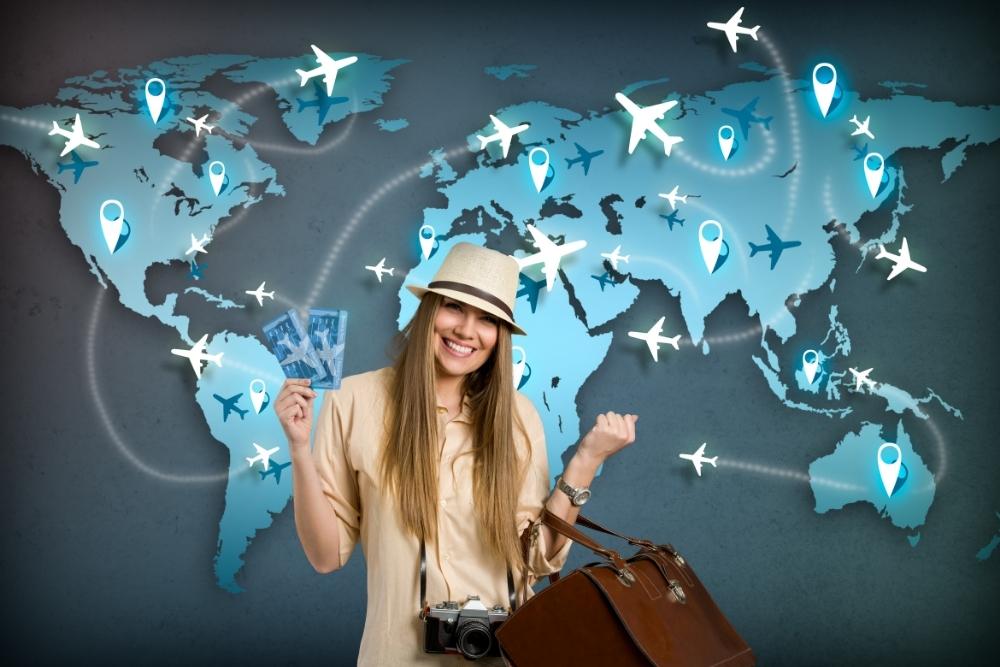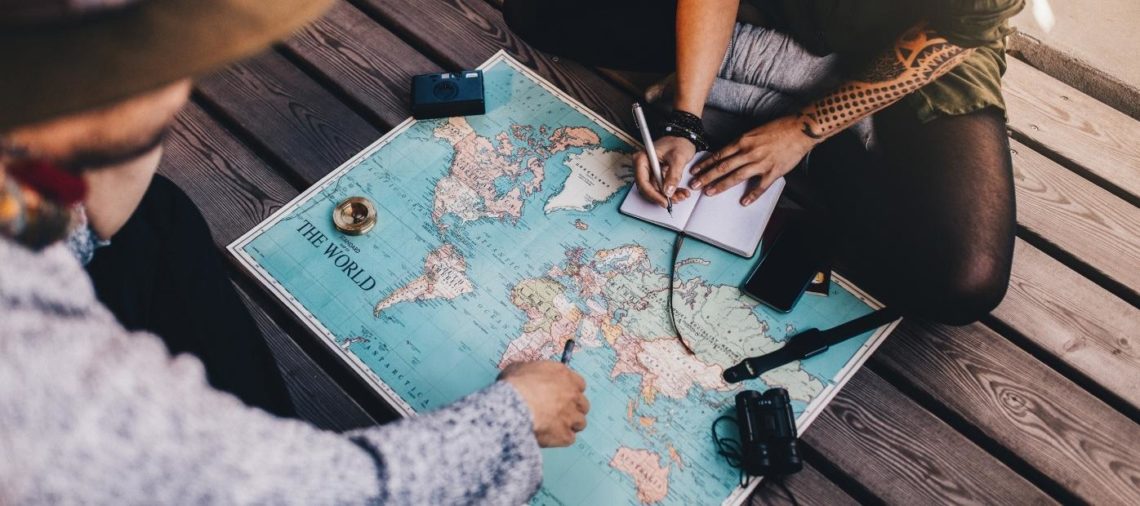Setting out to visit every continent in the world isn’t easy, but it’s more than possible if you start early and do your research. Why plan one trip when you can plan many? Start with these tips on how to plan a trip around the world and get ready to go places!
Ask yourself the right questions before you go in a trip around the world
When you travel, it’s important to make sure you have all your bases covered. To get started on planning your trip, ask yourself these questions:
- Where do I want to go?
- What do I want to see?
- What types of activities am I looking for?
- How much do I want to spend?
- How much time can I realistically spend in each place?
Are there any specific locations that are must-see spots on my itinerary?
It may be helpful to write down what you decide and refer back as needed. Even if it’s not an official itinerary, it’ll help you better remember your priorities. Also, keep in mind that most questions about planning can’t be simply answered by yes or no; instead, consider how these questions play into your ultimate goals and preferences. You don’t need to start with a firm itinerary; writing down some ideas will help clarify exactly what you want from your trip.
Choose your destinations

Choosing your destination is one of the two most important decisions you’ll make when planning a trip around the world. Wrong choices can doom your entire journey, but so can choosing too many places—no matter how much you want to see and do, it’s impossible to visit every place on earth in one trip. There are more than 7,000 cities around the globe, which means there are countless ways you could approach planning a tour of all of them. For example, if you want to plan a long-term trip to Europe, follow these tips.
However, to set yourself up for success, start with destinations that feel like they’re closer to home; traveling halfway around the world will be exhausting enough without throwing culture shock into the mix.
Getting your visa before booking is essential if you’re traveling outside of North America, Europe, or Australia/New Zealand. Some countries require visas for stays longer than 30 days; others require proof of hotel reservations and tickets booked before arriving.
When it comes to deciding where you want to go, follow your heart—but be smart about it. Research each destination you’re considering, and consider these questions:
1) What do I already know? Is there somewhere that holds sentimental value for me?
2) How long do I have? The longer you have, generally speaking, the better off you’ll be when planning a trip around the world. Longer trips allow for more flexibility and an opportunity to slow down and stay in one place for longer periods—so every day must count.
3) What am I looking for? Do you want beaches, culture, or adventure? Or all of these things? Figuring out what kind of vacation you’re looking for will help when researching each destination. The best way to do that is to set up Google Alerts for different attractions in your dream destinations—this way, every time something new comes up on your radar, you’ll be sure not to miss it.
4) When are you going (and can it be flexible)? Can you go now, or do you need to wait until next year? Can you travel for two weeks or three months? Planning around your schedule will help ensure that there will still be plenty to do even if you go during a busier season.
5) What’s your budget like? This may seem obvious, but choosing how much money to spend is as important as choosing where and when. For example, Fiji might be your top choice for a South Pacific island getaway—but unless you’ve planned with airfare and accommodations lined up, chances are, Fiji won’t fit into your grandiose plans. Before booking tickets to paradise, ask yourself: How far am I willing to stretch my wallet? If $1K isn’t realistic right now (or ever), put Fijian islands off-limits; try focusing instead on New Zealand or French Polynesia. While there’s certainly no need to break a bank account just because you’re dreaming of traveling around the globe, don’t let your love of luxury prevent you from seeing places outside of it. In other words, yes to Machu Picchu and no to Monte Carlo.
6) Are there activities I want to do there? If you have specific activities that you want to do in your ideal destination—whether it’s wine tasting in Sonoma, riding horses in Cusco, or rafting through chutes on Colorado’s Roaring Fork River—make sure those activities are available. It also doesn’t hurt to check if other things are going on while you visit; festivals and events can make any travel experience even more memorable.
7) How do I get there? What’s your preferred mode of transportation? Are you most comfortable flying, driving, or taking public transportation? Once you have an idea of what kind of travel will work best for you—regardless of whether it’s quick or leisurely—you can figure out how and where to book tickets. Many airlines offer deals for international flights that might not be available when booking online, so ask around at your local travel agency. Additionally, customer service agents might help you find other deals that you couldn’t find on your own. Don’t forget about price-matching: If a deal pops up in another country (or from another source), call up your favorite airline and see if they can match it—it never hurts to ask!
Get in shape for adventure travel
Prepare yourself mentally and physically. Traveling is hard on your body, so getting in shape before your trip is essential. It doesn’t have to be an endurance test, but make sure you can handle an intense hike if that’s part of your itinerary. If you plan to take frequent transportation (buses or trains), focus on lower-body workouts such as squats and lunges. Squats are especially useful because they strengthen your legs without putting too much strain on other parts of your body. If you don’t already exercise regularly, you should also work out for about 30 minutes every day—preferably five days per week. This will keep you from getting out of shape between trips, which could cause health problems later down the road. Finally, consider learning a new skill like language lessons or pick up an exciting hobby like rock climbing to keep things interesting while preparing for your journey!
Book airline tickets in advance

Some of us—myself included—plan at least part of our vacations around getting cheap airfare. If you’re trying to keep your spending down, booking your flight tickets far in advance is one of your best bets. If you book early enough, you can take advantage of introductory fares and discounts for travelers under 25. Most airlines let you save up to $100 per ticket if you book 21 days or more before departure; it’s also a good idea to sign up for airline newsletters so that you know about upcoming promotions, like free baggage fees on international flights. But be careful: Don’t wait too long because some deals have limited availability and could sell out fast!
Booking a flight for your upcoming vacation might seem like an intimidating process, but it’s easier than you think. Websites like Kayak, CheapOair, and Travelocity can help you find flights based on your budget and destination, with great search filters that make finding deals easier. You can also ask friends or other travelers where they booked their tickets or check out discussion boards online; these are great ways to get up-to-date information on new routes, promotions, and booking fees. Remember: The earlier you book, the better price you’ll get!
And don’t forget travel insurance! A good policy will help protect against injury or illness, lost baggage, and more—usually for less than $25 per month. Most policies include 24/7 access to a personal agent who can even assist in emergencies if something goes wrong while you’re away from home. Look into travel insurance before heading abroad because most health plans won’t cover any injuries sustained overseas—even if you only have partial coverage at home.
Write your itinerary for the trip around the world
Before you begin your journey, take time to figure out exactly where you’re going and how long you want to be there. Your itinerary should be customized for your interests, but expect at least two or three weeks for stops in Europe and five or six weeks if you want to spend time in Asia. If an around-the-world ticket is too pricey or not available, consider connecting flights that get you as close as possible to your destinations of choice. As far as lodging goes, Airbnb offers pretty much every type of accommodation imaginable, so there are lots of options for housing along your way; however, don’t forget about meeting locals!
Throughout your journey, take time every so often to step out of your comfort zone and experience new things. Try unfamiliar cuisine, explore local landmarks and cultural traditions, and don’t be afraid to talk with locals – you never know what you might learn! Above all else, don’t forget that traveling is about exploring, experiencing, and enjoying yourself. You should always have fun on your trip around the world!
Study like crazy before leaving in the trip around the world
One of your biggest challenges as an entrepreneur is motivating yourself daily. It’s tempting to believe that you can leave for your big adventure, start jetting off all over town, and everything will magically fall into place. You’ll meet interesting people and be exposed to tons of new cultures. You’ll find valuable lessons everywhere you go and emerge from your adventure more intelligent and more capable than ever before. But don’t let that simplistic idea fool you. The truth is, travel will never work without thorough preparation. Leaving at all in an unforgettable journey around the world helps set up some primary goals while studying like crazy before leaving.
Pack mindfully for the trip around the world
While planning your trip, you’ll have several major considerations. Packing tends to be one of them. Often when we travel far away, we don’t pack things as well as we do for local trips. Though it’s easy and convenient, waiting until everything is done on that last day is not ideal because you need time to repack items if they don’t fit in your suitcase or backpack. With experience, patience, and good organization skills, you can figure out what luggage you will need to bring with you based on how long your travels will be and where you are going.
Always consider any modes of transportation that you might use, such as planes, trains, or automobiles.
Some destinations may require unique clothing such as hiking boots for mountain climbing; others may call for more formal attire such as tuxedos for special functions. It is essential to choose your clothing wisely since some countries may be very hot while others cold so bringing clothes accordingly is wise. So be sure to consider weather conditions while packing since extreme heat or cold weather could potentially ruin your trip before it even begins.
Other items like electronics, food, and personal hygiene products should also be considered before making final decisions on what to pack while traveling abroad.
Conclusion
The world is an incredible, beautiful place. There’s so much to see and learn that it can be hard to know where to begin. If you’re one of those people who would rather see the sights than just read about them, take a moment to think about what unique places really interest you. Maybe you’re the type of person who would like to go off the beaten path and visit a location you haven’t heard anyone else speak of.
When planning your trip around the world, it’s best to have a rough itinerary in mind before you begin booking hotels or solidifying your travel plan. Map out where all of the stops on your international itinerary will be and make sure they fit together nicely before completing your project. You might find yourself making sudden changes or additions as you go along if you don’t start with a strong framework for your trip around the world in place. Having a solid game plan from day one will save you from any unforeseen hiccups later on down the line.
You may also like: 10 mistakes we make at the airport




